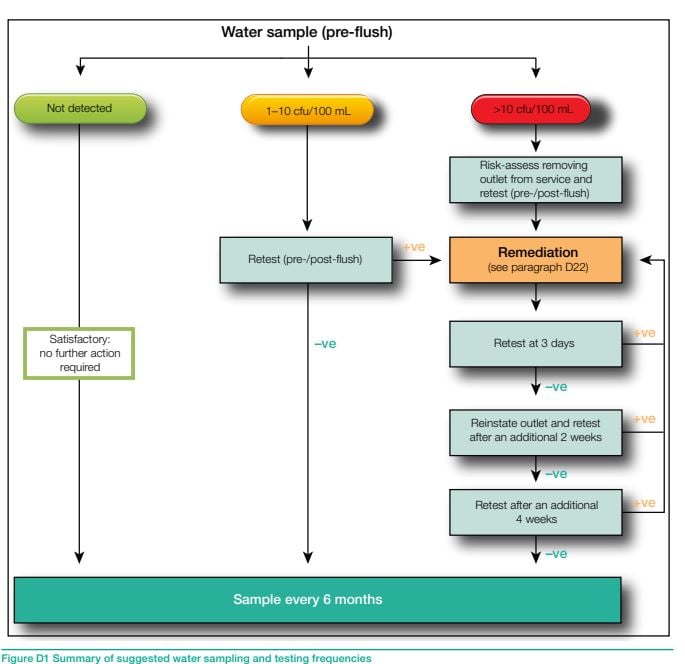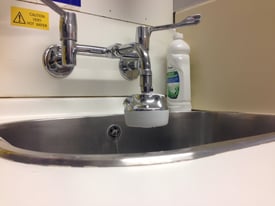To understand the actions that should be taken when a positive Pseudomonas aeruginosa [P. aeruginosa] test result is received, it is prudent to first understand more about this opportunistic pathogen and the associated guidance. This knowledge will help to shape the actions…
What is Pseudomonas aeruginosa?
- P. aeruginosa is a microorganism that is part of the natural flora and fauna of the human body;
- It is an ‘opportunistic’ pathogen that can contaminate/colonise moist/wetted environments, such as the end of taps (and up to 2-metres of associated pipework);
- P. aeruginosa is well-known for its antibiotic resistance capabilities and within the healthcare environment, the associated risk and cost of infection from this pathogen are significant.
HTM 04-01 - Water Safety Group & Water Safety Plan
HTM 04-01 Parts B and C prescribe methods for mitigating the risk of contamination/colonisation with P. aeruginosa; including the need for the Water Safety Group [WSG] to commission and agree on a Water Safety Plan [WSP] that considers the risk from P. aeruginosa to patients.
Most care that is designated as augmented will be that where medical/nursing procedures render the patients susceptible to invasive disease from environmental and opportunistic pathogens such as Pseudomonas aeruginosa and other alert organisms.
If there are augmented care areas within the healthcare organisation then these need a Legionella Risk Assessment and a sampling plan established. BS8580-2 “Water quality – Part 2. Risk assessments for Pseudomonas aeruginosa and other waterborne pathogens - Code of practice”, gives comprehensive guidance for carrying out a risk assessment that is over and above the Legionella risk assessment.
The new standard considers additional risk factors within the associated environment leading to conditions that can encourage the colonisation and growth of waterborne pathogens and transfer of antibiotic resistance.
The HTM 04-01 Part B details where samples should be taken so that sampling is not a ‘fishing’ exercise! Appendix E gives guidance on sampling for P. Aeruginosa. The Water Safety Group should agree on the sample points and ensure that the Water Safety Plan outlines the actions to take.
Pseudomonas aeruginosa positive results?
Samples taken should be pre-flush samples which means that they should be taken immediately after the outlet is opened and ideally after a significant period of no use (at least 2 hours). On confirmation of a positive P. aeruginosa test result, Infection prevention and control (IPC) teams will decide whether an outlet is to remain in normal use, be fitted with a point-of-use microbiological filter, be taken out of service and agree on what remediation to take.
The HTM 04-01 Part B, Appendix D ‘Action Plan’ can assist this decision-making process by offering clear guidance on recommended remedial and re-sampling actions dependent upon the number of bacterial cells recovered within a given sample.

Flushing of outlets
A significant proportion of P. aeruginosa positive test results are attributed to infrequent use or poor flushing of the outlet(s). Upon receipt of a pre-flush positive test result, it’s indicated, in HTM0401, to increase flushing thus increasing the movement of water and retest the outlet in three days.
Moreover, the bacterial count will often reveal ‘how’ an outlet is used in practice; so, whilst it’s recommended to start flushing of affected outlets (to not exacerbate stagnation), the bacterial count will often determine whether or not the outlet is to be kept in service.
Sampling for Pseudomonas aeruginosa
A CFU is defined as a single, viable propagule that produces a single colony (a population of the cells visible to the naked eye) on an appropriate semisolid growth medium.
Should routine sampling return a pre-flush water sample test positive for P. aeruginosa with a reported count between 1-10 cfu/100ml, then it’s indicated to re-sample pre and post-flush. If the re-samples return clear results (i.e. ‘0’ or ‘Not Detected) then sampling will revert to once every 6-months.
 When P. aeruginosa counts between 1-10 cfu/100ml are initially reported from a previously unaffected outlet it’s not indicated to remove the outlet from service. However, it is prudent to consider that the only safe level of P. aeruginosa is ‘0’ as water sample results are only a ‘snapshot in time’. This often results in the outlet being removed from service or the installation of a point-of-use water filter until a subsequent sample tests clear of P. aeruginosa.
When P. aeruginosa counts between 1-10 cfu/100ml are initially reported from a previously unaffected outlet it’s not indicated to remove the outlet from service. However, it is prudent to consider that the only safe level of P. aeruginosa is ‘0’ as water sample results are only a ‘snapshot in time’. This often results in the outlet being removed from service or the installation of a point-of-use water filter until a subsequent sample tests clear of P. aeruginosa.
Sampling for this pathogen is only indicated within high-risk patient areas and many of these patients will have suppressed immunity and/or underlying health problems which make them more susceptible to infection and subsequent disease.
When test results report bacterial counts of >10 cfu/100ml then it’s indicated to risk assess removing the outlet(s) from service and re-sample the affected outlet(s) three days after any remediation – during which time flushing should be increased.
Following receipt of a clear test result from the 3-day test, the outlet can be reinstated to normal service and subject to retesting after an additional 2 weeks, and 4 weeks provided that outlets continue to test clear. Should outlets test positive following the 3-day test then additional remedial works are typically required:
- Clean, disinfect or replace affected outlet/components/pipework;
- Review cleaning processes – avoiding cross-contamination;
- Ensure that the hot water system is operating within specification and that hot water circulation is properly balanced;
- Review the use of the outlet – a wash hand basin is designed for washing hands and not for disposal of body fluids or dirty water!
- The position of the tap into the wash hand basin – avoid splash and spray including direct fall of the water onto the waste opening at the bottom.
Conclusion
In summary, for as long as water outlets are well maintained, used or flushed and water temperatures remain within specification then problems seldom occur with P. aeruginosa.
When issues occur with positive water sample results, refer to the Water Safety Plan, which will in turn detail the need for reviews to take place involving the three key stakeholders of estates, domestics and healthcare workers/IPC. Further advice can also be sought from the Authorising Engineer(Water). Each is to ensure that their interactions with the affected outlet are not the root cause.
Avoid water stagnation – slow-moving or stagnant water encourages the growth and proliferation of P. aeruginosa (and other waterborne bacteria).
Adequate engineering control – ensure that hot and cold-water systems remain within specification i.e., control water temperature and eliminate components that encourage P. aeruginosa.
Cleanliness – ensure that outlets are cleaned correctly to help mitigate the risk of P. aeruginosa (and other waterborne bacteria) infecting the ‘local system’ and outlets. P.aeruginosa is often spread by the user touching the outlet so correct cleaning protocol is paramount.
Appropriate use of hand-wash basins – they are designed for washing hands and nothing else e.g., not for disposal of bodily fluids!
> Legionella Sampling Academy Video
Feel free to reach out if you have any questions about the issues mentioned above or if you would like to consult with one of our experts on water hygiene.
Editors Note: The information provided in this blog is correct at the date of original publication - August 2022.
© Water Hygiene Centre 2022










